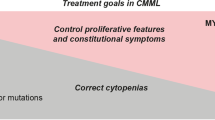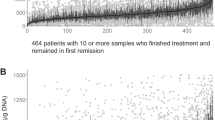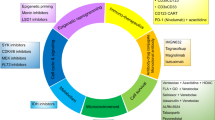Abstract
Etoposide, an effective agent for acute lymphoblastic leukemia (ALL), can cause secondary acute myeloid leukemia (AML) in a subset of patients. Our objectives were to determine whether patients who develop secondary AML displayed altered etoposide pharmacokinetics or other pharmacologic characteristics compared to identically treated patients who did not develop AML. Children with newly diagnosed ALL were treated according to a protocol which included etoposide 300 mg/m2 given three times over 8 days during remission induction and once every 2–4 weeks during 120 weeks of continuation therapy. Characteristic 11q23 rearrangements were documented in seven of the eight patients with AML. Etoposide clearance, time that etoposide concentrations exceeded 10 μM, etoposide or etoposide catechol area-under-the-plasma-concentration vs time curve (AUC), serum albumin, and average methotrexate concentration did not differ significantly between the two groups; thiopurine methyltransferase (TPMT) activity tended to be lower in the eight children who did vs the 23 matched control children who did not develop AML (P = 0.16). Further regression analyses likewise indicated that lower TPMT activity tended to be associated with shorter onset of secondary AML (P = 0.11); it also tended to be lower among the eight index cases compared to the entire unmatched cohort of 105 identically treated children with ALL (P = 0.10). We observed no statistically significant differences in etoposide disposition and antimetabolite pharmacology between patients who did and did not develop secondary AML.
This is a preview of subscription content, access via your institution
Access options
Subscribe to this journal
Receive 12 print issues and online access
$259.00 per year
only $21.58 per issue
Buy this article
- Purchase on Springer Link
- Instant access to full article PDF
Prices may be subject to local taxes which are calculated during checkout
Similar content being viewed by others
Author information
Authors and Affiliations
Rights and permissions
About this article
Cite this article
Relling, M., Yanishevski, Y., Nemec, J. et al. Etoposide and antimetabolite pharmacology in patients who develop secondary acute myeloid leukemia. Leukemia 12, 346–352 (1998). https://doi.org/10.1038/sj.leu.2400928
Received:
Accepted:
Published:
Issue Date:
DOI: https://doi.org/10.1038/sj.leu.2400928
Keywords
This article is cited by
-
Chemical exposure and infant leukaemia: development of an adverse outcome pathway (AOP) for aetiology and risk assessment research
Archives of Toxicology (2017)
-
Apoptosome activation, an important molecular instigator in 6-mercaptopurine induced Leydig cell death
Scientific Reports (2015)
-
Risk of myeloid neoplasms after solid organ transplantation
Leukemia (2014)
-
Long-term results of St Jude Total Therapy Studies 11, 12, 13A, 13B, and 14 for childhood acute lymphoblastic leukemia
Leukemia (2010)
-
Thiopurines in current medical practice: molecular mechanisms and contributions to therapy-related cancer
Nature Reviews Cancer (2008)



